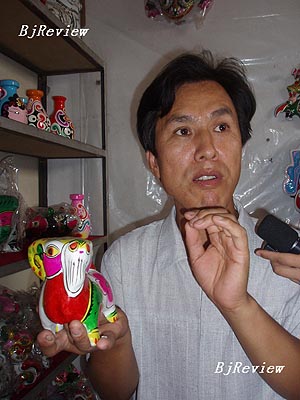|

For a long while, China's vast northwestern areas have been lagging behind other regions in China in economic development. In many people's minds, the northwestern countryside is synonymous with poverty and backwardness. But the situation there is changing with the implementation of the Western Development Strategy, which was launched by the government in 1999, and the area is experiencing a new era of growing economic vigor.
Exporters of folk art
"Young villagers who went to the eastern provinces for odds jobs have come back to the village in droves," said 42-year-old farmer Hu Xinming, "The market for our products is expanding." For large areas of China's countryside, the salary brought back by rural migrant laborers has become the pillar income source for local farming families. What drives the backward flow of Hu's fellow villagers is the folk art of painted clay sculptures, a craft that has been passed down through the generations over the past 1,000 years. Hu has become the master artisan and designer of clay sculptures in his village
Hu's 2,000-people village, located in western Shaanxi Province, is home to several traditional crafts --- painted clay sculpture making, embroidery and paper cutting. The most famous of these is painted clay sculpture making. For a long time, making painted clay sculptures has been a favorite pastime among families in the village.
"I started to learn how to make clay sculptures from my parents as early as I can remember. This is also how many people around me picked up this craft," said Hu. The painted clay sculptures in Hu's village are made of six natural materials, including soil, cotton and sticky rice. Most sculptured figures depict gods and beasts from folktales, or express happiness and wish for a good harvest. The sizes of the sculptures vary from a few centimeters to several meters tall.
Worried that the ancient art might not survive his generation, Hu started to think about methods to revive the ancient art. He explored new technical skills to improve the quality of clay sculptures. After carrying out more than 180 experiments over a period of three years, Hu succeeded in enhancing the rigidity of the clay sculptures, a problem that had been inhibiting their long-distance transport.
A golden period dawned for the craft as a result. In 2002 and 2003, which were the Year of the Horse and the Year of the Sheep respectively, according to the Chinese zodiac, painted clay figures of a horse and a sheep designed by Hu were chosen as the images on memorial stamps, beating over 10,000 other design bids. In 2007, Hu won the bid for memorial zodiac stamps again with a vivid painted clay pig for the Year of the Pig.
Hu's victories were an excellent advertisement for the clay sculptures, earning overnight fame for the ancient art. Soon, what had once been regarded as inexpensive clay toys became gifts from the Chinese Government to visiting state leaders, including the ex-U.S. President Bill Clinton. One third of the village's annual production of 400,000 pieces is exported to around 30 countries across the world, including the United States, Japan, France and Germany.
Seeing the good returns, the number of families making clay sculptures has rocketed from two households of less than eight people to over 300 households of more than 1,200 people. Revenue has also jumped from less than 16,000 yuan five years ago to nearly 6.8 million yuan.
Meanwhile, an exhibition of the manufacturing process has made the village a new tourism spot, drawing almost 20,000 people every year. Many villagers have taken advantage of the influx of visitors by opening restaurants, hotels and souvenir shops.
Hu envisions an even brighter future for the painted clay sculptures. In May 2006, painted clay sculptures were listed as a project for national intangible cultural heritage protection. Hu, then the vice chairman of the provinicial association of folk artists, saw this as an opportunity to rejuvenate folk art. He invested a total of 2.3 million yuan to build a theme park focused on local folk traditions and crafts, where folk art works are manufactured and exhibited and the crafts are taught to younger artisans. The one-hectare theme park also has folk art performances, entertainment facilities, restaurants and hotels for vacationers.
|
